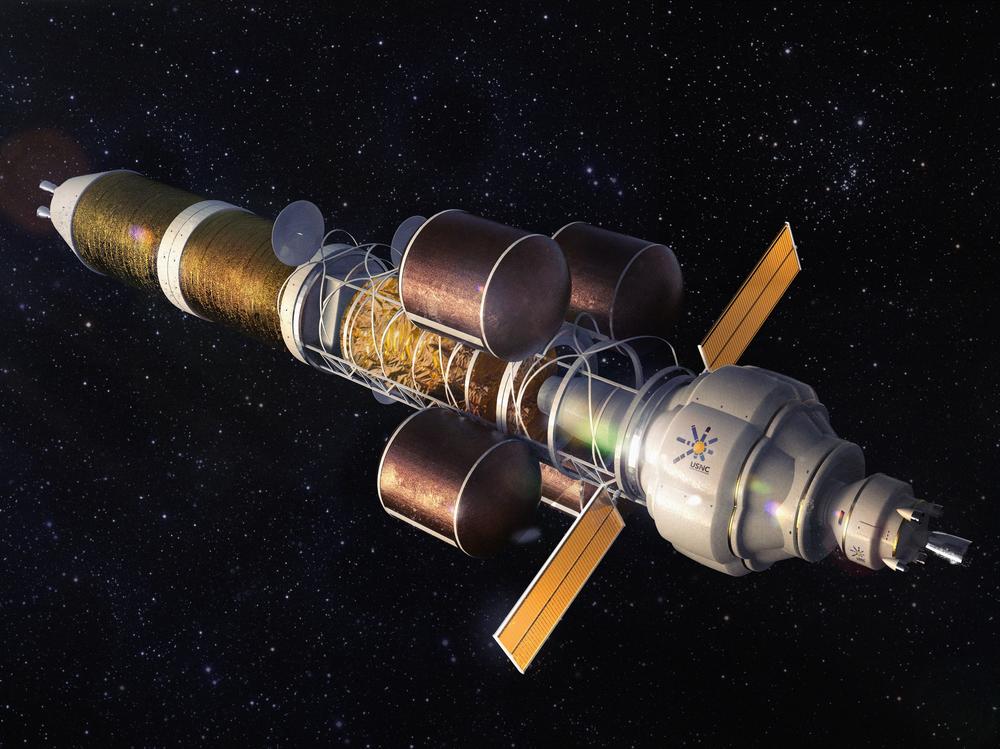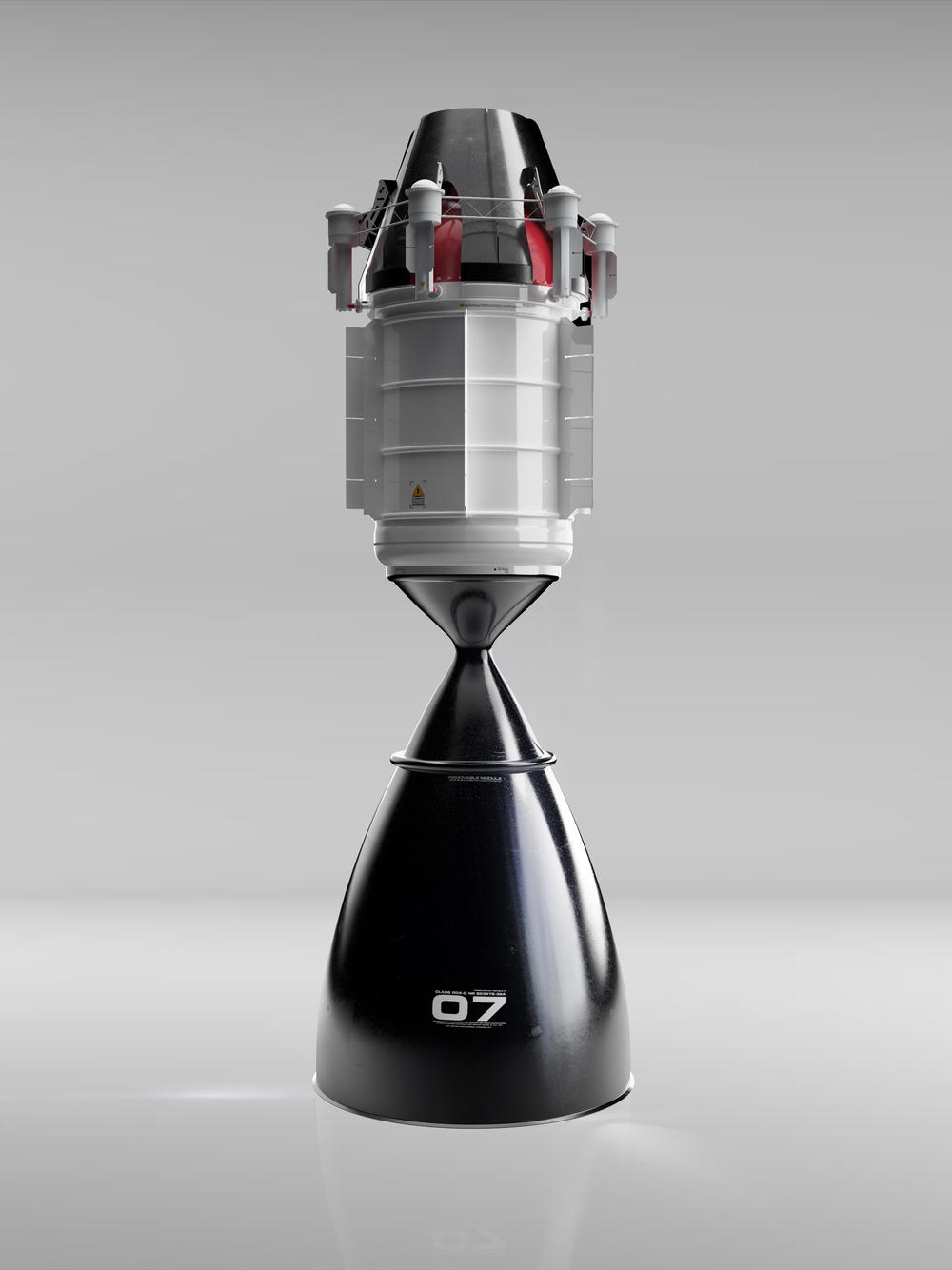Section Branding
Header Content
Experts Ponder Nuclear Rockets To Send Humans To Mars
Primary Content
When NASA's Perseverance rover touched down on the Martian surface last week, humans cheered from the confines of planet Earth.
But if the space agency or others hope to leave and send astronauts to Mars, experts say they need to consider a technology that was studied decades ago but never fully developed: nuclear-powered rockets.
"If we decide to send humans to Mars, nuclear propulsion is likely to be central to that journey," says Roger Myers, an independent aerospace consultant and co-chair of a panel convened by the National Academies to study nuclear propulsion.
A new report out from Myers and his colleagues suggests that NASA should begin studying nuclear propulsion now, if it hopes to use it in a Mars mission in 2039. Although NASA does spend some money studying the technology, Myers says, funding is "going to have to be ramped up significantly if we're going to hit 2039."
The idea of using nuclear reactors for propulsion dates back to the earliest days of the U.S. space program. In the 1950s and 1960s, scientists with what was then called the Atomic Energy Commission developed a series of nuclear rockets. The program was conducted in collaboration for NASA and developed working prototypes. But it was cancelled in the early 1970s, after it became clear the missions for which it was needed, to travel to Mars and the moon, were unlikely to go forward.
The technology has had sporadic funding in the years since, even as other technologies for space travel have continued to develop. Most notably in the case of Mars, Myers says scientists and engineers have made incredible strides in robotic technology to explore the Red Planet.
"We can do a tremendous amount of fantastic science with robots, as we're discovering today," Myers says.
Getting humans to Mars is another matter. "There are many factors that need to be considered, including such things like how fast can you get there? How long do you have to stay on Mars? How quickly and how reliably can you get back?" he says.
Those questions, he says, are all about one thing: minimizing the time from when astronauts leave earth, to when they return. The trip must be as fast as possible, but going quickly takes fuel. For even the most basic human trip to Mars, Myers and the panel believe around a thousand tons of propellant would be necessary.
That would come from Earth, on many dozens of little rockets that could be used to gas up a larger, Mars-bound spacecraft. It would be expensive and dangerous, and even with all the propellant, astronauts would be required to stay on Mars for 500 days while waiting for a planetary alignment that would let them get back to earth using as little propellant as possible.
Nuclear power, by contrast, could allow the mission to be completed with less fuel and in a shorter amount of time. Because of the extra thrust provided by nuclear rocket motors, astronauts would be able to take a shortcut back to Earth by spiraling around the Sun and Venus. The mission would also mean a shorter first stay on Mars of only about a month, as opposed to 500 days.
"If you want to go to Mars, nuclear is a smart choice," says Vishal Patel, a nuclear rocket scientist with the company called Ultra Safe Nuclear Corporation.
Patel and his colleagues are working on the version of a nuclear rocket previously tested by the U.S. It involves shooting hydrogen gas through the core of a specially designed nuclear reactor. The hydrogen would cause the reactor to heat up, which in turn would make the hydrogen expand out of a nozzle, causing thrust.
Patel says so far, the design looks promising. "The chemistry looks good, the nuclear physics looks good, the manufacturing seems to be going in the right direction," he says.
A second kind of nuclear rocket would use the nuclear reactor in a more conventional way. In this version, the reactor would generate electricity that could then be used to power a different rocket motor, such as an "ion thruster" of the sort used on some satellites.
The National Academies found each design had significant challenges that would need to be overcome before they were ready for humans. For the nuclear rocket using hydrogen, materials would have to be developed that could tolerate the enormous temperatures inside the reactor core. The rocket would also need advanced hydrogen storage so that its fuel didn't leak.
The nuclear electric system, by contrast, would need giant radiator panels protruding from the spaceship to help deal with heat generated by the reactor. It would also require more research to figure out how to integrate the reactor with different kinds of thrusters and power systems.
Patel recognizes that launching a nuclear reactor from earth might make some people nervous, but he says Ultra Safe Nuclear Corporation is working hard to make it...ultra safe.
"We'll be using conventional rockets to get it up into space, and we'll have safety measures in places just in case the chemical rocket does malfunction," he says.
The nuclear reactor would remain shut off throughout its trip off of Earth's surface, and even if the rocket exploded, it would not melt down. Astronauts would not activate the nuclear rocket system until their Mars-bound spacecraft was a safe distance from earth.
The reactor would also be shielded to protect the astronauts from its radiation, Patel says. But Myers adds the larger radiation risk comes from space itself. Both the Sun and the Milky Way galaxy put out powerful radiation that can be harmful to anyone outside of Earth's atmosphere. Nuclear rockets would protect astronauts by keeping the travel time through space as short as possible, he says.
Ultimately it remains unclear whether nuclear rockets will be able to get off the ground. Developing the technology is enormously expensive, and there are still many obstacles to making it work. In a statement, NASA said it would "will further review the committee's recommendations and share them with stakeholders."
Myers says he believes NASA should at least begin investing to see whether such rockets could play a role in humanity's first trip to Mars. "Right now we don't have the data to make good decisions on these systems," he says.
Copyright 2021 NPR. To see more, visit https://www.npr.org.


